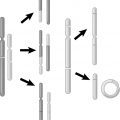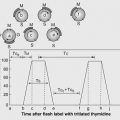1
INTERACTION OF RADIATION WITH MATTER
JOHN F. GRESKOVICH, JR., MIHIR NAIK, AND MARC APPLE
Question 1
What type of decay does Radium-226 undergo, and what particles are produced in the decay?
Question 3
What is the relationship between photon energy, wavelength, and frequency?
Question 1 What type of decay does Radium-226 undergo, and what particles are produced in the decay?
Answer 1
Radium-226 decays by α-decay, creating radon gas (Rn-222) and an alpha particle plus 4.87 MeV of released energy. An alpha particle is a helium nucleus consisting of two protons and two neutrons. The emission of an alpha particle decreases the atomic number by two and the mass number by four.
Hall EJ, Giaccia AJ. Physics and chemistry of radiation absorption. In: Hall EJ, Giaccia AJ, eds. Radiobiology for the Radiologist. 7th ed. Philadelphia, PA: Lippincott Williams & Wilkins; 2012:3–11.
Question 3 What is the relationship between photon energy, wavelength, and frequency?
Answer 3
The higher the photon energy, the higher the frequency and the smaller the wavelength. Therefore, photon energy is proportional to frequency and inversely proportional to wavelength. This is formalized in the relationship called Planck’s equation: E = hv where E is energy in Joules (J), h is Planck’s constant, 4.13 × 10−18 keV-sec, and v is the frequency in Hertz (Hz, sec−1). Using the electromagnetic wave equation, c = λv we can arrive at the equation E = hc/λ where c is the speed of light, 3.0 × 108 m/sec.
A useful equation is: Energy (keV) = 12.4/λ(angstroms) where angstrom = 10−10 m.
Hall EJ, Giaccia AJ. Physics and chemistry of radiation absorption. In: Hall EJ, Giaccia AJ, eds. Radiobiology for the Radiologist. 7th ed. Philadelphia, PA: Lippincott Williams & Wilkins; 2012:3–11.
Question 5
What is the energy range for visible light? x-rays and γ-rays? Why doesn’t visible light cause ionization in tissue?
Question 7
What is the difference between x-rays and γ-rays?
Question 5 What is the energy range for visible light? x-rays and γ-rays? Why doesn’t visible light cause ionization in tissue?
Answer 5
Using the equation Energy (keV) = 12.4/ λ (angstroms), we can calculate the energy of visible light as 1 to 3 eV since the λ for visible light is 4,000 to 7,000 angstroms. The energy for x-rays and γ-rays are typically in the keV to MeV range since the λ for x-rays and γ-rays are in the 102 to 10−4 angstrom range. Visible light does not cause ionization in tissue since the average energy for an ionizing event is 34 eV, significantly higher than the 1 to 3 eV energy of visible light.
Hall EJ, Giaccia AJ. Physics and chemistry of radiation absorption. In: Hall EJ, Giaccia, AJ, eds. Radiobiology for the Radiologist. 7th ed. Philadelphia, PA: Lippincott Williams & Wilkins; 2012:3–11.
Question 7 What is the difference between x-rays and γ-rays?
Answer 7
X-rays and γ-rays are two forms of high-energy electromagnetic radiation. They are not different in their physical properties, but their designation reflects the different ways that they are produced. X-rays are produced extranuclearly and γ-rays are produced intranuclearly. For example, x-rays are produced in an electrical device that is used to accelerate electrons and stop them abruptly in a target made of a metal like tungsten or gold (i.e., linear accelerator). However, γ-rays are emitted by radioactive isotopes and represent excess energy that is given off as an unstable nucleus breaks up and decays to reach a more stable form.
Hall EJ, Giaccia AJ. Physics and chemistry of radiation absorption. In: Hall EJ, Giaccia AJ, eds. Radiobiology for the Radiologist. 7th ed. Philadelphia, PA: Lippincott Williams & Wilkins; 2012:3–11.







